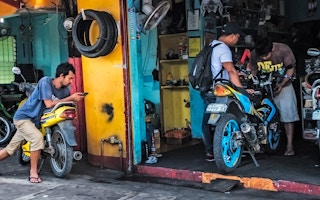Of the over 2 billion unbanked adults in the world, about half live in developing Asia, where typically women and self-employed are excluded from the financial system.
Several countries have established national strategies for financial inclusion, including digital finance. India, Indonesia, Mongolia, Myanmar, Pakistan, and the Philippines are promoting digital financial services in the broader context of access to finance for the poor.
McKinsey & Co. reports that over 700 million consumers now use digital banking regularly in Asia. Although it is still low penetration, the use of digital banking is rapidly increasing in developing Asia.
However, digital financial services have so far failed to justify their value addition to poor households and small businesses. This is caused by both supply-side and demand-side factors.
As part of my study, I conducted field research on the payment behavior of small businesses in the Philippines, interviewing low-income managers and shopkeepers in Metro Manila. All interviewees stressed that cash is most trusted for payments; they hesitate to use digital options such as card and mobile because they lack basic knowledge about those services.
There is some psychology behind this. Low-income people are likely to avoid new and unknown tools, as they fear they could lose the little money they have.
“
Mobile money allows the poor to make low-cost, fast, safe, and easy transactions without going to physical branches, and encourages a cashless society.
Marketing failure by digital financial services providers, my research confirmed, is another constraint. Some interviewees stressed that computer-generated marketing messages never resonate with them, and being cold-called makes them feel uncomfortable.
Poor households conduct mainly small transactions, and do so without using formal financial services, relying instead on informal ways to transact. They often feel that their income is so unstable that they cannot prepare adequately for future life events that may require special payments. This leads them to a cash-based economy.
The Financial Diaries methodology, widely used in many countries, brought us a critical lesson to develop digital financial services for the poor. It is a research approach started in India, Bangladesh, and South Africa to track cash and non-cash monetary flows of poor households and helps understand their financial behaviors and usage patterns.
Findings from the Financial Diaries programs suggest that financial products must be adapted to respond better to real-life needs so more poor people are persuaded to use new financial tools like digital finance. In other words, we need to understand the poor customers, their real problems and needs, and show possible and concrete solutions to make their life better by using digital financial services.
Developing Asia’s digital finance potential
The main reason that the potential of mobile money is not being fully realised should be also addressed. Among people with access to finance, only 1 per cent have a mobile money account, and another 1 per cent have both bank and mobile accounts. Half of the digital accounts of the banked are inactive, and half of the active accounts are empty.
Why is this happening? Digital accounts are often not used as a store of value for future payments of school fees, weddings, or funeral expenses, but rather as a pass-through for immediate payments.
Many people don’t understand the concept of stored value, and tend to regard savings as simply unspent money. Moreover, cash is accepted and trusted while digital money is not. This is much evident in poor households in developing Asia.
Mobile money has the big potential to improve the daily lives of the poor, as proved by the most successful story of M-Pesa in Kenya. Mobile money allows the poor to make low-cost, fast, safe, and easy transactions without going to physical branches, and encourages a cashless society. To promote mobile money for the poor, service providers need to justify the benefits advertised.
A 2017 report by business intelligence firm GSMA indicated that mobile adoption has been rising in Asia-Pacific. Mobile subscribers numbered 2.7 billion in 2016 and estimated reaching 3.1 billion by 2020 in the region, which is three quarters of the population.
The trend is led by the People’s Republic of China and India, but Southeast Asian countries such as Indonesia, Malaysia, Myanmar, and the Philippines have also shown high a smartphone adoption ratio, over 50 per cent. This is justified by looking at poor households in the Philippines.
ADB staff members recently visited poor communities living in Kasiglahan, on the outskirts of Metro Manila. We spoke to a family that earns about Php500-600 ($10-12) per day, working 10 to 15 days per month, and supporting three children.
The parents lack a bank account and don’t borrow informally, but have small savings in a box. Their living condition is among daily survival but they have a smartphone and a tablet, which the children use to complete their school homework.
Since they can’t afford to buy books, the kids study online because the community has a basic internet connection. They pay Php7 per week to a neighbor to use internet. This suggests the huge potential of delivering digital financial services to the poor.
Now I’m wondering if digital finance is a pipe dream for the extremely poor, since their primary concern is daily survival. Maybe it isn’t. Given the high mobile penetration rate in some developing Asian countries, data connectivity can unlock digital financial services for those who have almost nothing.
Shigehiro Shinozaki is a Financial Sector Specialist (SME Finance), Sustainable Development and Climate Change Department, at the Asian Development Bank (ADB).
This piece was published with permission from ADB.











